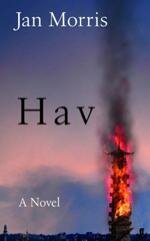

Hav by Jan Morris
Reviewed by Paul Kincaid
Faber & Faber, London, 2006, 301pp, £16.99, h/b, ISBN 0-571-22983-2
The period, roughly, from the mid-1960s to the mid-1980s was the golden age of British travel writing, when richly evocative writers like Patrick Leigh Fermor, Colin Thubron and Norman Lewis were producing their best work. One of the finest and most distinctive members of that elite was Jan Morris, who was unusual in writing mostly about cities rather than journeys, and who managed to imbue the city with a vivid and individual personality. In 1985 she used all her distinctive qualities as a travel writer to produce an extraordinary fantasy, Last Letters from Hav. Written as a travelogue, it describes her sojourn of several months in the remote and independent land of Hav, a peninsula cut off from Anatolia by an immense and forbidding escarpment, reached primarily by direct rail line from Moscow, and at various times occupied by Greeks, Arabs, Russians, Chinese, British and others. Here the Cathars still survive, the British agency seems to be a central point in the espionage game, there are troglodytes still living in the escarpment, and traditions from the time of the Saracens still survive. It is a book suffused with a sense of loss, a prolonged and exquisite lament for the passing of a world. Although there are lots of names in the book, lots of people that 'Jan' encounters during her stay, there are few real characters, but the character of Hav itself is huge and overwhelming. I cannot think of a single fantasy writer who could not learn from this book how to give depth and solidity to a place by the patient accumulation of detail: the way the market operates, the unique Havian fruit of snow raspberries, the extraordinary roof race, the old woman living in seclusion who still recalls when Hav was a summer retreat for Tsarist aristocracy, the curious architecture of the Chinese tower in the old town. And on and on and on, by the end you understand why some readers of the original novel believed it described a real place.
At the end of that first book Morris was forced to flee Hav ahead of unknown invaders. Now, twenty years later, she has returned. This new volume reprints Last Letters from Hav and adds to it a novella, 'Hav of the Mymidons'. If the original novel was a lament for the passing of the eccentric, individualistic old world, this new novella is a lament for the world that has replaced it. After the 'Incursion', as it became known, the secret Cathars in Hav emerged to take control of the country, proving their descent from the Mymidons of Achilles and establishing a religious republic. Although she meets many of the same characters, it is hard to believe that this is the same place. The character has changed dramatically. The rare snow raspberries are now flavourless, mass-produced GM crops; the roof race has lost all its idiosyncratic nature thanks to health and safety officers, and religious repression has replaced divergence with conformity. There are hi-tech wonders to appreciate, and the people of Hav are certainly better off, but at what cost. If Last Letters from Hav is an exercise in nostalgia, the sequel represents a more straightforward sadness.
This article first appeared in Vector 250. Back issues of Vector are available from
